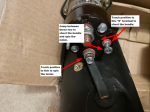Using the jumper cables should tell you if your battery cables have an issue.The slo-blo fuse is interesting. I've never seen those before. The wire that feeds 24v to the starter relay dose originate from a fusible link at the junction block. Maybe it was a bad idea adding another fuse just before the relay. But.... before I pulled the starter I ran a jumper straight from the battery post to the starter solenoid. Originally I had an inline fuse in the jumper. Once it blew I cut the fuse out & touched the unfused wire to the battery post quickly. It arced & stuck to post instantly. The solenoid clicked but the starter didn't spin the engine over. I did all this w/the ignition wire from the truck disconnected. I'll try the jumper cables thing soon as I get a chance. That's a good idea.
I can tell you that when I first bought my truck, the *ground* cable was smoking it got so hot trying to start the truck. I looked at the cable attached to the battery and there was corrosion in the clamp. I took it apart and cleaned it with a steel brush and some electrical contact cleaner and put it back together. Tried to start, now the red cable coming from battery 1 to battery 2 was hot and smoking. Again, looked at the clamp...corrosion. Took it apart and cleaned it. No more issues (well with heat...it was a multitude of issues causing the hard start, the least of which was 8 bad glow plugs, loose starter with the bracket disconnected, and bad flex plate).
You have to have a clean ground from the engine to the body as well.
All of these things will cause resistance which will generate heat, hence a fusible link in the circuit which is a heat-based "fuse" and not specific amps.
One last thing...those *are* 24V solenoids, correct? Do you have a part number?
Last edited:



